KATY - PART VII
The return of Officer David to finish the wiring presents us with a car that has a cooling system, oil, fuel and sparks. It’s time to press the button. She barks into life quite swiftly, which means she now lives.
As we’ve already done clutch and brakes, the box and prop etc are on, this thing is now driveable. Well, if you didn’t mind getting a seatbelt eye jammed up you, there’s no seat yet.
The cage is in, and now welded into place, and painted at last, so in can go the rear window, side windows, trim, exterior trim panels, screen, screen trim etc. The chrome parts are now black. Some of the black are now fake carbon. It is just that little bit more aggressive looking.
Belts and a seat jump in, both were measured off the old shell before we got shut of it, so it all fits. No passenger seat because we’ve read the new regs and if we fit a 3.6 litre engine we can have a car that is 50kg lighter, and that has to be the way forward. Weight, that we weren’t worried about, is now important again.
Inside the car David has done a cracking job of retaining all the facelift dash and switchgear, rewired to operate the older car. A couple of bespoke aluminium panels to mount things off and a smothering of carbon vinyl, and a more racy, purposeful cockpit comes to life. Sealed in with a screen and suddenly she’s looking a lot like an actual car.
A full test of all the electrical equipment shows her working, and that’s David’s job done, he can go home and leave us to the messy finish. Because it’s panel time. We won’t bore you with the laborious tale of salvage, sanding, and painting of a pile of secondhand panels, but it took time. A lot of time. Boot, doors, wings, spoiler, all to be prepped. Amusingly the boot and spoiler came off a car that Philip knew well, he rolled it at Cadwell, we bought the wreck and now he gets them back again.
Paint takes time. The two-colour scheme, and the panels being painted off the car, leaves a strong possibility that the lines on the panels won't line up with the lines on the shell. But what is the alternative, paint them on the car? No. We'll just have to be better and get it right. Ish. It is a racing car, after all.
As finished panels go on, the transformation from sculpture into vehicle is swift. Bear asks if the car isn't a bit too pretty for its purpose. I wonder if he doesn't have a point.
Time for wheels. We want light, and open-spoked, because the 888s have a lot of grip, grip means late braking, and that means a lot of heat. Lots of heat murders brakes. We have a decent wheel choice, and we have the option of fitting 17” rims, but they tend to be heavier. Unusually therefore, and we suspect we won’t be alone in this, we ignore the option to fit a component that might be more consistent with modified class equipment, we simply don’t need it, the smaller, lighter wheel is better.
And so she’s ready to roll. She starts, stops, and steers. That’s all we ask for now.
To Cadwell, for testing. Usual trackday stuff, book an open pitlane day and go round and round to see what falls off. It’s the first time Philip has met the new car. No stickers etc yet, but clearly a very different machine, there is a clean look to any purpose-built car, you can tell it was intended rather than adapted.
And judging from the driver’s feedback, he was a happy bunny, because she tore round the place as if on rails, pilot comments mostly consisting of gleeful noises. His last experience of a fettled car was when we turned his deathtrap into a proper car, but this thing is another step further, and he’s amazed. Which was the point.
That decision is to be based entirely on the weight of the car. If it’s closer to 1500kg than 1450, then we leave it as a 4 litre and add ballast. If it’s nearer to 1450, then we find some more weight to remove, and put a 3.6 in. This engine is knackered whichever way you look at it, so it has to come out, but we do need to know which to put in….
Do the mathematics say that the torque loss is overcome by the weight saving? Now I like torque, but I like lightweight, but which one's better? There's only one way to find out...
We have a 3.6 handy. Mated to a skimmed AJ16 head we figure it’s pretty close to 4 litre power, and the reduced weight of the car acts threefold. It’s all well and good having power, but that only accelerates you. Speculation at this point is pointless.
We have a snag list from Cadwell to work through before we declare this ready, and the entire car, though only an hour old, needs a complete stem to stern spanner check.
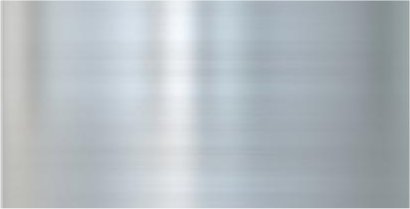

The moment of truth. Bear hooks up the positive lead.

The boot came out quite nicely in the end. It looks a lot more expensive than it is.

Belts and seat have jumped in. Interior trim nearly completed.

The most comfortable race seat either of us have ever sat in. We can't work out why, but it is.

Panels part-painted and trial fitted. It almost looks like a car.

Stripes. We can't quite work out if this is a silver car with blue, or a blue car with silver. It's close.

Bootlid under prep. Rainlight fitted. Bumper on. Stuff happening.

Spoiler, colour-coded rainlight, numberplate light fitted. Regs say lighting must be MOT standard...

Old bonnet beaten back into shape, louvred, filled and prepped. Time for paint.

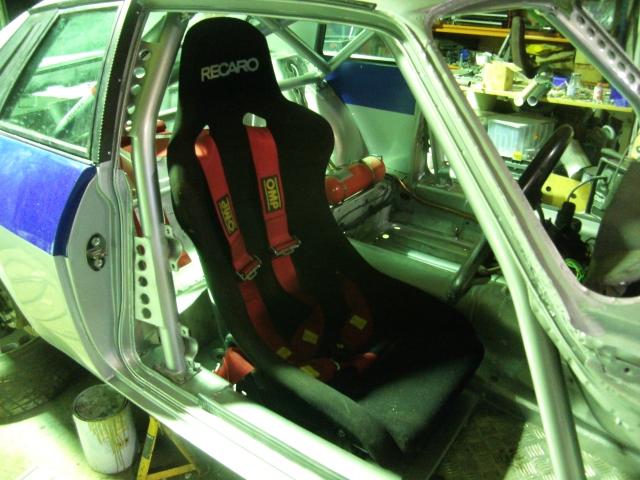


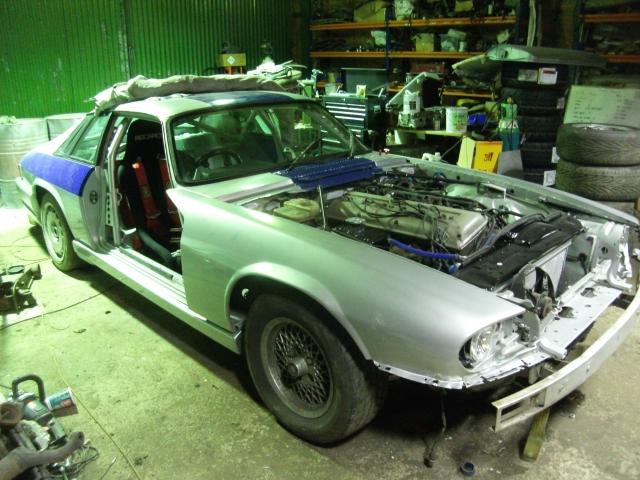
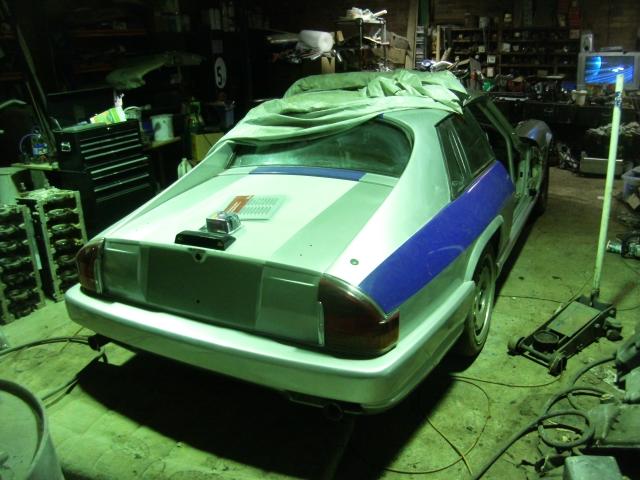
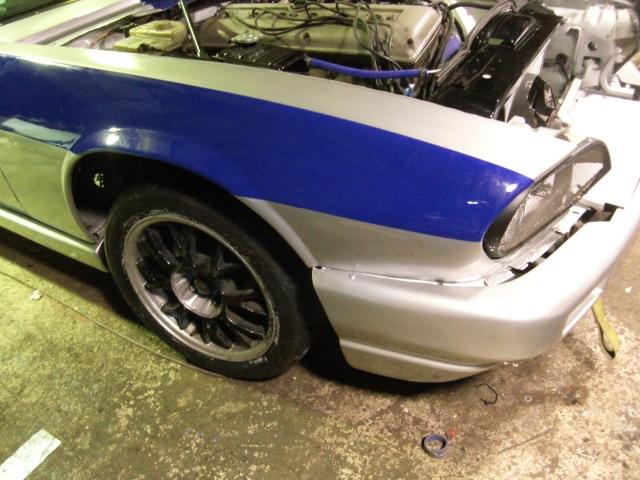




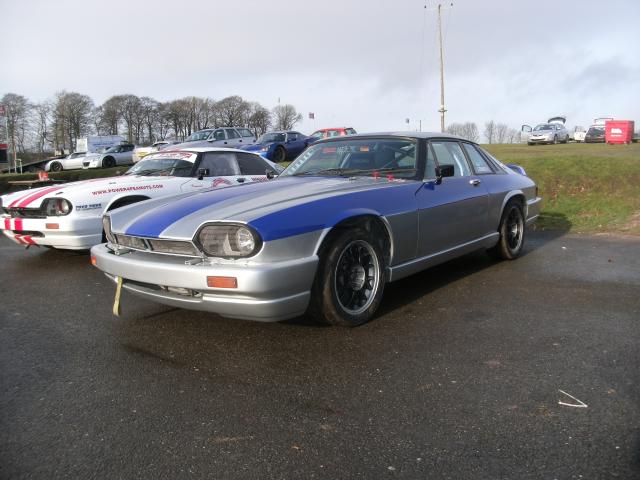
A meshed, black-painted grille and headlight surrounds, and she looks pretty finished. There are a few finishing touches of course, door cards, wire cable inner door pulls/releases, huge numbers of tiny little tweaks, but she’s ready for now, she can go testing.
The bonnet also took time, the one that we’d prepped to use was captured by the wind and flung to its death, so eventually I decided that with some judicious panel beating and the fitment of louvers, the old bonnet could be saved. Which worked so well that you really can’t tell that it had been creased to begin with. These are our favourite repairs.
A day to fit all these parts, and don’t get me started about the messing around this takes. You can move a door in 3 dimensions, you can also skew it in each dimension, and you can shim or pack it in several ways too, which gives you something like 81 possible ways of adjusting each door. Then you have to make the wings line up, and the front bumper fit. It all absorbs the hours.
For now though, we're calling the primary build finished. On time, on budget, another silk purse from a sow's ear. With time and dedication, any car can live again.

The engine bay also came out pretty well too. Infill panels tidy up both appearance and airflow.

The two-colour door cards were because it amused us. Cable door pulls on the other hand are purely practical.

Lined up at Cadwell ready for a shakedown test.
Doesn't look half bad, if we say so ourselves.